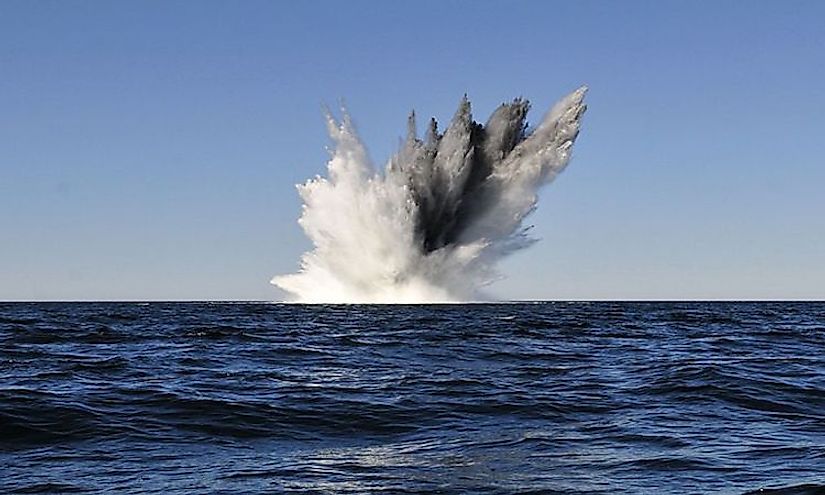Countries With the Highest Number of Landmines

Unexploded ordnance, also known as explosive remnants of war or unexploded bombs, include landmines, grenades, cluster munitions, bombs, shells, or naval mines that did not explode when they were used and they still pose a risk several years after they were deployed. Unexploded armaments can be traced as far back to the civil war in the United States between 1861 and 1865. The main threat with unexploded armaments such as mines is that over time the main charge and detonator deteriorates to the extent that makes them highly sensitive slight disturbance thus making the devices dangerous to handle.
The Dangers Posed By Unexploded Ordnance
In cases where people have tampered with old unexploded ordnance, the results are usually fatal. There is often the belief that unexploded ordnance is harmless due to their old age. However, such assumptions can cost lives because the minute the device is handled it can explode and potentially injure or kill people around the blast zone. Therefore, it is highly recommended and advisable that such devices if discovered should be left undisturbed until a qualified person usually the bomb disposal expert can be notified of the location or the police and the area should be evacuated until it is safe again.
Examples Of Unexploded Ordnance Fatalities
Despite Explosive Ordinance Disposal (EOD) personnel being professional and possessing expert knowledge, equipment, and skills on explosives, they are also at huge risk due to the inherent dangers. An example is the Allied 500-kilogram bomb that detonated resulting in three deaths and six severe injuries to the German EOD experts who were getting ready to disarm the explosive in June 2010. The EOD personnel who had more than 20 years of experience and had rendered over 600 unexploded ordnances safe were notified and called to the scene after construction workers in Gottingen, Germany discovered the bomb which dated back to World War II that was planted about seven meters underground. Another example is the massive bomb that exploded at a building site in Euskrichen in January 2013 which was dropped by an allied aircraft during World War II. The aftermath of the explosion resulted in the death of the digger operator, injured eight other people, and damage to properties around the blast zone. Four United States Marines were killed in November 2013 when unexploded ordnance they were trying to remove detonated. There have been fatal explosions in different countries in the world like the US, Japan, Belgium, France, Laos, the UK, Lebanon and many others.
International Law On Unexploded Ordnance
According to the international law, Protocol V of the Convention on Certain Conventional Weapons, cites that when the active hostilities between involved parties has ceased, each party is required to clear their area of any remaining unexploded ordnance. However, land mines are not covered in Protocol V but in Protocol II of the Convention under which involved parties are required to clear their area of land mines following the cease of active hostilities.
Countries With The Highest Number Of Deployed Mines
Deployed mines continue to pose grave danger years after they were deployed during conflicts and battles. Deployed mines continue to fatally injure or kill civilians each year around the world and they render land in some places impassable. Despite the use of mines being prohibited, there are many land mines deployed in many countries throughout the world. The United Nations estimates that even with advanced technology used to detect and clear land mines it might take approximately 1,100 years for all mines in the world to be cleared. Currently, Egypt is the leading country in the world with deployed mines accounting for 23 million followed by Iran with 16 million mines. The position of the third leading country with deployed mines is held by four nations namely Afghanistan, Angola, China, and Iraq with ten million mines each. Cambodia comes in as the seventh country in the world with the highest number of deployed mines accounting for 7 million, followed by Bosnia and Herzegovina with six million mines. Kuwait and Vietnam take positions nine and ten with 5 million and 3.5 million mines respectively.
Countries With The Highest Number Of Mines Deployed In Their Territory
| Rank | Country | Mines (Millions, estimated) |
|---|---|---|
| 1 | Egypt | 23 |
| 2 | Iran | 16 |
| 3 | Afghanistan | 10 |
| 4 | Angola | 10 |
| 5 | China | 10 |
| 6 | Iraq | 10 |
| 7 | Cambodia | 7 |
| 8 | Bosnia and Herzegovina | 6 |
| 9 | Kuwait | 5 |
| 10 | Vietnam | 3.5 |











